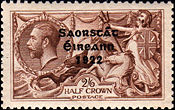Portal:Philately/Selected article archive/4
Overprints are postage stamps to which a text (and sometimes graphics) have been applied after their printing. Overprints have been used for several purposes, serving as rate surcharges, commemorations, control marks or the validation of stamps by a new postal administration. Precancels, also, are overprinted stamps.
Some overprints alter or confirm the face value of a stamp. These are commonly produced when some needed types of stamps are unavailable, whether because new shipments have been delayed, because circumstances have changed too quickly to get appropriate new stamps, or simply to use up existing stamps. Surcharging during the German hyperinflation of 1921-1923 is one such example. Many countries have used surcharges when converting to new currencies, for example many Commonwealth countries chose to convert to decimal currency in the late 1960s. Also, some incoming postal administrations have overprinted the stamps of an earlier administration to show the new administration's authority, as happened in Ireland in 1922.
Overprints have been used as commemoratives, as they are a lower-cost alternative to designing and issuing special stamps. The United States, which historically has issued very few overprints, did this in 1928 for issues commemorating Molly Pitcher and the discovery of Hawaii. Overprints applied by an entity other than an official stamp-issuing agency are called "private overprints."

